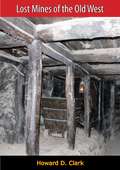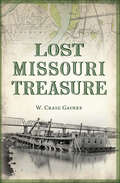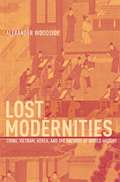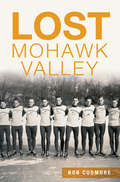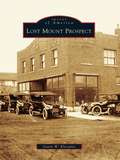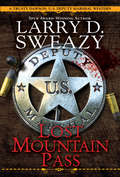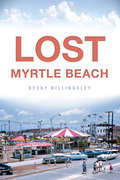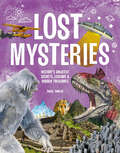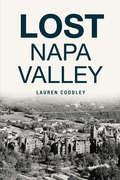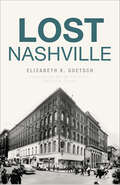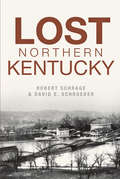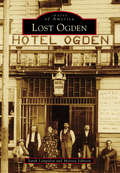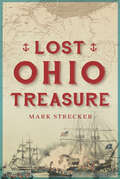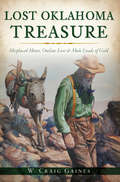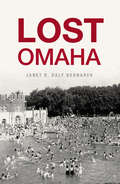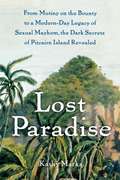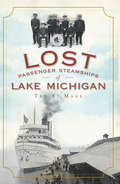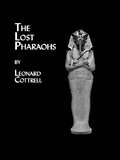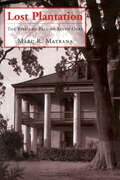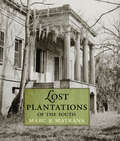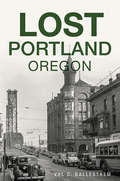- Table View
- List View
Lost Mines of the Old West
by Howard D. Clark Ray HetheringtonAUTHENTIC STORY OF THE “PEGLEG” AND 21 OTHER STORIES OF FABULOUS LOST MINES!Author Howard D. Clark, a Kansas native, had an extensive career in journalism with appointments including managing editor for the Farm Press Publications of Chicago, Illinois; staff writer for a number of business papers; and statistical and analytical specialist for other periodicals and concerns.This background, plus extensive travel on the Pacific Coast, fitted him particularly well to undertake the writing of this book. Lost mine legends make up a large section of Western folklore. In this collection he has made a sincere effort to present only the most important and best authenticated of them all. He has also had the invaluable assistance of Ray Hetherington, an unquestioned authority in the field of Western Americana. Much of the source material used herein was collected by Mr. Hetherington through thirty years of extensive research.First published in 1946, this collection of lost mine legends is considered among the most complete and factual of any ever assembled.
Lost Missouri Treasure (Lost)
by Craig GainesLost and Forgotten Gems of Missouri History From the mining industry to the shipping industry to the Civil War, Missouri has lost a lot. Emigrants and traders have lost countless values during their travels. The Civil War caused a loss of not only citizens, but numerous valuable historic items. The host of outlaws who traversed the area have hidden loot that has never been found. Join author Craig Gaines as he details the state treasures lost to time.
Lost Modernities: China, Vietnam, Korea, and the Hazards of World History (The Edwin O. Reischauer Lectures #2001)
by Alexander WoodsideIn Lost Modernities Alexander Woodside offers a probing revisionist overview of the bureaucratic politics of preindustrial China, Vietnam, and Korea. He focuses on the political and administrative theory of the three mandarinates and their long experimentation with governments recruited in part through meritocratic civil service examinations remarkable for their transparent procedures. The quest for merit-based bureaucracy stemmed from the idea that good politics could be established through the "development of people"--the training of people to be politically useful. Centuries before civil service examinations emerged in the Western world, these three Asian countries were basing bureaucratic advancement on examinations in addition to patronage. But the evolution of the mandarinates cannot be accommodated by our usual timetables of what is "modern." The history of China, Vietnam, and Korea suggests that the rationalization processes we think of as modern may occur independently of one another and separate from such landmarks as the growth of capitalism or the industrial revolution. A sophisticated examination of Asian political traditions, both their achievements and the associated risks, this book removes modernity from a standard Eurocentric understanding and offers a unique new perspective on the transnational nature of Asian history and on global historical time.
Lost Mohawk Valley (Lost)
by Bob CudmoreLife in the Mohawk Valley today is vastly different from generations ago. Long gone are the factory whistles calling workers to their shifts in old mill towns. Fort Plain still benefits from little-known inventor William Yerdon, and Utica baseball player George Burns was so skilled that fans called left field "Burnsville." Few realize that a local artist shared a special bond with John Philip Sousa, one of the nation's greatest musicians. The Tamarack Playhouse was once the venue of spectacular theatricals, and as time goes on, there are fewer alumni to remember Amsterdam's Bishop Scully High School. Local author Bob Cudmore shows that while lost, these and other compelling stories no longer need be forgotten.
Lost Mount Penn: Wineries, Railroads and Resorts of Reading (Lost)
by Mike MadaioGerman immigrants of the nineteenth century brought their traditions of winemaking and mouthwatering cuisine to the slopes of Mount Penn high above Reading.With a Santa Claus beard and a long-stemmed pipe, the hermit of Mount Penn, Louis Kuechler, founded Kuechler's Roost, where travelers flocked for feasts, literary soirees and free-flowing local wine. The opening of the Mount Penn Gravity Railroad brought a flurry of tourists from around the nation and fueled the creation of resorts throughout the countryside. Spuhler's Hotel hosted renowned pig roasts from noon until midnight. The fresh waters of Lauterbach Springs attracted wine and outdoor enthusiasts alike. Author Mike Madaio explores the vibrant society and culinary culture that made Mount Penn one of the best-known resort regions in the country until financial difficulties and the passage of Prohibition spelled its end.
Lost Mount Prospect (Images of America)
by Gavin W. KleespiesMount Prospect dates back to the 1840s. The village has a fascinating legacy as an immigrant community, an ambitious small town, an early progressive suburb, and a classic postwar community. However, few of today's residents are aware of this legacy. Much of Mount Prospect's past has been overshadowed by the incredibly rapid development of the past half century. The population of Mount Prospect in 1950 was around 4,000 people, the population was almost 19,000 by 1960, and today it approaches 60,000. This amazingly rapid development fundamentally changed how Mount Prospect saw itself and redefined the community's landscape. Many of the older buildings were demolished to make way for new developments or were modernized and are now hard to identify. The farms and early industries were replaced with houses and shopping areas. By the time this rapid development was over, it was hard to see what had been here before. Lost Mount Prospect is an examination of this history. It is a look at the village through the lens of what no longer exists.
Lost Mountain Pass (Trusty Dawson, U.S. Deputy Marshal #1)
by Larry D. SweazyFirst in a brand new series from Spur Award-winning author Larry D. Sweazy, a lawman&’s grave mistake sends him gunning for justice against a gang of badmen whose violent trail of bloodshed ends at Lost Mountain Pass . . . Kosoma, Indian Territory. The outlaw Darby brothers have been sentenced to hang until dead. Witnessing the exectution are Amelia Darby, sister of the condemned men, as well as U. S. Deputy Marshal Sam &“Trusty&” Dawson and Judge Gordon Hadesworth. After justice is served, Trusty hits the trail, escorting the Judge—and begrudgingly, Amelia—back to Oklahoma. Ambushed en route, the Judge is murdered and Amelia vanishes, leaving Trusty to believe she led them into a trap for revenge. To find Amelia, Trusty will have to put his faith in Father Michael Darby, a fourth brother who gave up his criminal ways to take up the cloth and collar. Unwilling to let his sister continue to fall to the wicked evil that claimed the rest of his family, Michael joins the hunt for Amelia. But as their journey turns deadlier by the day, Trusty starts to doubt that Michael is truly on the righteous path… Praise for Larry D. Sweazy&’s Westerns "Combines the slam bang action of a good Western with the sensitivity of style and depth of character that used to be the hallmark of literary fiction."—Loren D. Estleman, Spur Award-winning author "Raw, wild, and all too human . . . a thundering testament to just how good the Western novel can be."—Johnny D. Boggs, Spur Award-winning author
Lost Myrtle Beach (Lost)
by Becky BillingsleyMyrtle Beach has long been a favorite vacation spot for families across America, giving parents and children alike a lifetime of memories. The Myrtle Beach Pavilion, considered by many to be the heart of the city since 1908, was demolished in 2007. The Ocean Forest Hotel was as beautiful as a castle, and resembled one, during its forty-four-year span. Members of World War II's Doolittle Raid trained at the Myrtle Beach General Bombing and Gunnery Range, which eventually became Myrtle Beach Air Force Base until its closure in 1993. Join author Becky Billingsley for a trip back in time as she examines some of the city's most memorable attractions.
Lost Mysteries: Secrets, Legends & Treasures of the Past
by Paige TowlerHistory is full of the weird, wild, and wacky—and in this interactive adventure book with 250+ photos, middle grade readers uncover the incredible mysteries of our worldKids ages 7+ will discover why history is the coolest subject ever with mind-blowing stories about ancient civilizations, dinosaurs, hidden treasures, pirates and moreHow were the ancient Egyptian pyramids built and who was King Tut? How did the Titanic sink and where is Blackbeard&’s pirate treasure? Did scientists really find a new dinosaur in the basement of a museum, or an entire city buried underneath the Amazon rainforest? And…why was a 2,000-year-old block of butter stuck in a swamp?In Lost Mysteries, you&’re on the case! This incredible fact file provides a thoroughly researched and up-to-date look at every mystery and delves into clues, theories, and exciting new finds from the past that still need to be explored. The secrets of the past are yours to uncover!Start sleuthing to find out about the most incredible mysteries of our world, such as: Why some ancient civilizations disappeared without a traceWhere you can find Bigfoot and other mythical monstersWhy a famous king was buried underneath a parking lotHow the art thieves who stole the iconic Mona Lisa were caughtAnd so many more thrilling facts and theories!This collection of exciting, real-life stories is packed with facts and groundbreaking science that takes readers on a captivating journey to unlock the secrets of the past. It&’s the perfect book for kids who love incredible history stories, parents looking for fun boredom busters or gifts for curious kids, or middle grade teachers who are looking to enrich their social studies curriculums.
Lost Napa Valley (Lost)
by Lauren CoodleyNapa Valley, once known for its cattle and silver mines, has grown into an international wine destination. On the way, many buildings and institutions have vanished. From the Von Uhlit family's fruit farm in Napa to the Wheeler Ranch in St. Helena, fields and orchards became neighborhoods and vineyards. The Dolphin, a steamboat that once delivered travelers from San Francisco, was replaced by faster transport, and the Napa State Hospital's original "castle" was demolished. The Sawyer Tannery, in operation for over one hundred years, closed its doors in 1990, and destinations like the Kay Von Drive-In and the Bel Aire Bowl now live on only in memory. Join author and historian Lauren Coodley as she celebrates these once-beloved landmarks in California's Wine Country.
Lost Nashville (Lost)
by Elizabeth K. GoetschNashville is chock-full of music landmarks, but there are quite a few historic structures that have been lost to time. The elegant Maxwell House Hotel served a breakfast blend that grew into the nationally known coffee brand. Public transportation first arrived in Nashville by way of horse-pulled streetcars in the 1860s. Fort Negley was the largest stone fort built during the Civil War. The Nashville Female Academy once served as the largest school for young ladies in the United States during the nineteenth century. Author Elizabeth Goetsch digs into the archives for some of the Music City's lost structures.
Lost Northern Kentucky (Lost)
by Robert Schrage David E. SchroederNorthern Kentucky has a unique location as the gateway between the North and the South. Many of its historic businesses, religious structures, homes and buildings were lost to time. Just after the Civil War, Daniel Henry Holmes purchased a large Victorian-Gothic house he named Holmesdale, better known as Holmes Castle. By the 1890s, the Latonia Racetrack had two hundred stables to accommodate horses and space for one hundred bookmakers. The Motordrome at the Ludlow Lagoon Amusement Park had seating for eight thousand people. Authors Robert Schrage and David Schroeder detail the fascinating history of Northern Kentucky's lost treasures.
Lost Off Trevose: The Shipwrecks of Cornwall's Trevose Head
by Brian FrenchThe ship that will not obey the helm must obey the rocks. Trevose Head, the land mass jutting out into the Atlantic from North Cornwall's shore, has been called the Lizard of the North Coast. This beautiful but inhospitable coast has seen many disasters over the centuries, from ocean-going sailing ships blown off course to coastal vessels bound for Wales and the Bristol Channel foundering and colliding, and colliers blowing up. Both world wars also saw intense activity off Trevose as German U-boats attempted to prevent supplies from reaching the UK. The torpedoing of HMS Warwick in February 1944 deeply affected the whole community.This illustrated history reveals the many shipwrecks to plague the notorious Trevose Head and considers the development of safety at sea, starting with the erection of Trevose Lighthouse in 1857, a project strenuously opposed by most seafarers at the time as it was believed that lighthouses attracted pirates like moths to a flame. A must for all shipwreck and local historians and those with a love of the Cornish coastline.
Lost Ogden
by Sarah Langsdon Melissa JohnsonFrom a fur-trapping fort to a thriving metropolitan community, change has always been a part of Ogden's history. Settled in 1850 by Mormon pioneers, Ogden was forever transformed by the arrival of the transcontinental railroad in 1869. As horse-drawn carriages gave way to motor cars, a busy downtown district grew up around Ogden's Union Station and notorious Twenty-fifth Street. Landmark businesses, such as J.G. Read & Brothers Company and the Broom Hotel, became a part of the city's unique identity. Also unique to the city were its celebrations and special events, like parades, musicals, and sporting competitions. While change has always come to Ogden, the memories remain.
Lost Ohio Treasure (The\history Press Ser.)
by Mark StreckerThe Buckeye State is rich in buried treasure stories, but what's true and what's not? Wild yarns and plausible legends cling to a number of historical events, including the French and Indian War, Confederate general John Morgan's raid into Ohio, Prohibition, John Dillinger's bank robbing career, and the California Gold Rush. The hope of finding these riches has inspired treasure hunters since Ohio became a state. But enthusiasm has its drawbacks, for many an Ohioan has been duped by con artists toting everything from divining rods and magic tomes to dubious devices like the "scientific gold compass." Author Mark Strecker dives deep into historical record to test the credibility of these tales and others.
Lost Oklahoma Treasure: Misplaced Mines, Outlaw Loot & Mule Loads of Gold
by W. Craig GainesOklahoma keeps its secrets. Adventurers combing the Wichita Mountains for the legendary Lost Cave with an Iron Door can slake their thirst at Cache Creek or Treasure Lake. Following the tradition of French and Spanish explorers, miners and pioneers stashed their valuable discoveries along the Santa Fe Trail and the California Road. Chief Opothleyahola reportedly buried gold coins that could be worth more than $14 million today, while businessman Dr. John J. Hayes never returned from a Confederate refugee camp to reclaim his hidden fortune. From the unrecovered loot of the James Gang to the fabled funds of the Knights of the Golden Circle, W. Craig Gaines tracks tales of treasure across sixty Oklahoma counties.
Lost Omaha (Lost)
by Janet R. BednarekThe landmarks of Omaha's past reveal a history of industry, innovation and change. The Hotel Fontenelle, the Omaha Athletic Club and the Medical Arts Building disappeared in the wake of changes remaking downtown after World War II. Jobbers Canyon, a vital part of the city's wholesale district, was sacrificed to ConAgra's headquarters. Peony Park closed as suburban sprawl prevented its expansion, and changing leisure patterns took residents farther away for their amusement park experience. The stockyards finally closed in 1999, ending a long chapter in Omaha's history. Author and historian Janet R. Daly Bednarek charts the legacy of Omaha's lost history through its landmarks.
Lost Oregon Streetcars
by Richard ThompsonThe streetcars that plied Oregon’s small-town streets were every bit as diverse as those in Portland and their history even more fascinating. Learn of the devastating 1922 fire that scorched Astoria’s plank road railways and put a halt to its once-thriving streetcar network. Muse over the tale of a beloved white horse named Old Charlie that proved more efficient at powering Albany’s streetcars than the alternative steam locomotive. Laugh at the spectacle of university students being carted back to their dormitories on the Eleventh Street Line’s special midnight “drunk express” trains. Take pride in the tiny town of Cherry Grove, which became the first in the West to embrace new battery technology. Local historian Richard Thompson celebrates the lost trolley lines that transported Oregon’s people across the state for decades.
Lost Over Laos: A True Story Of Tragedy, Mystery, And Friendship
by Richard Pyle Horst FaasIn 1971, as American forces hastened their withdrawal from Vietnam, a helicopter was hit by enemy fire over Laos and exploded in a fireball, killing four top combat photographers: Larry Burrows of Life magazine, Henri Huet of Associated Press, Kent Potter of United Press International, and Keisaburo Shimamoto of Newsweek. The remoteness of the crash site made a recovery attempt impossible. When the war ended four years later, the war zone was sealed off and the helicopter incident faded from the headlines. But two journalist colleagues-the authors of this book-returned to Laos twenty-seven years later to resolve mysteries about the crash and pay homage to their lost friends.
Lost Paradise: From Mutiny on the Bounty to a Modern-day Legacy of Sexual Mayhem, the Dark Secrets of Pitcairn Island Revealed
by Kathy MarksPitcairn Island -- remote and wild in the South Pacific, a place of towering cliffs and lashing surf -- is home to descendants of Fletcher Christian and the Mutiny on the Bounty crew, who fled there with a group of Tahitian maidens after deposing their captain, William Bligh, and seizing his ship in 1789. Shrouded in myth, the island was idealized by outsiders, who considered it a tropical Shangri-La. But as the world was to discover two centuries after the mutiny, it was also a place of sinister secrets. In this riveting account, Kathy Marks tells the disturbing saga and asks profound questions about human behavior. In 2000, police descended on the British territory -- a lump of volcanic rock hundreds of miles from the nearest inhabited land -- to investigate an allegation of rape of a fifteen-year-old girl. They found themselves speaking to dozens of women and uncovering a trail of child abuse dating back at least three generations. Scarcely a Pitcairn man was untainted by the allegations, it seemed, and barely a girl growing up on the island, home to just forty-seven people, had escaped. Yet most islanders, including the victims' mothers, feigned ignorance or claimed it was South Pacific "culture" -- the Pitcairn "way of life." The ensuing trials would tear the close-knit, interrelated community apart, for every family contained an offender or a victim -- often both. The very future of the island, dependent on its men and their prowess in the longboats, appeared at risk. The islanders were resentful toward British authorities, whom they regarded as colonialists, and the newly arrived newspeople, who asked nettlesome questions and whose daily dispatches were closely scrutinized on the Internet. The court case commanded worldwide attention. And as a succession of men passed through Pitcairn's makeshift courtroom, disturbing questions surfaced. How had the abuse remained hidden so long? Was it inevitable in such a place? Was Pitcairn a real-life Lord of the Flies? One of only six journalists to cover the trials, Marks lived on Pitcairn for six weeks, with the accused men as her neighbors. She depicts, vividly, the attractions and everyday difficulties of living on a remote tropical island. Moreover, outside court, she had daily encounters with the islanders, not all of them civil, and observed firsthand how the tiny, claustrophobic community ticked: the gossip, the feuding, the claustrophobic intimacy -- and the power dynamics that had allowed the abuse to flourish. Marks followed the legal and human saga through to its recent conclusion. She uncovers a society gone badly astray, leaving lives shattered and codes broken: a paradise truly lost.
Lost Passenger Steamships of Lake Michigan
by Ted St. ManeFrom the arrival of the first steamship to Lake Michigan in 1821 through the turbulent booms and busts of more than 130 years, passenger steamers of this bygone era provided an essential link for immigrants, excursionists, businesspeople and leisure travelers. On offer were dining, dancing, day trips and luxurious shipboard settings, but mishaps like storms, fires and shipwrecks were a persistent danger to passengers and crew alike. Through fascinating tales and splendid images, Lost Passenger Steamships of Lake Michigan presents the romantic and sometimes dangerous story of a vanished industry that once connected communities all long Lake Michigan's shores.
Lost Pharaohs
by CottrellPublished in the year 2006, Lost Pharaohs is a valuable contrubution to the field of History.
Lost Plantation: The Rise and Fall of Seven Oaks
by Marc R. MatranaAlong the fertile banks of the Mississippi River across from New Orleans, planter Camille Zeringue transformed a mediocre colonial plantation into a thriving gem of antebellum sugar production, complete with a columned mansion known as Seven Oaks. Under the moss-strewn oaks, the privileged master nurtured his own family, but enslaved many others. Excelling at agriculture, business, an ambitious canal enterprise, and local politics, Zeringue ascended to the very pinnacle of southern society. But his empire soon came crashing down. After the ravages of the Civil War and a nasty battle with a railroad company, the family eventually lost the great estate. Seven Oaks ultimately ended up in the hands of distant railroad executives whose only desire was to rid themselves of this heap of history. Lost Plantation: The Rise and Fall of Seven Oaks tells both of Zeringue's climb to the top and of his legacy's eventual ruin. Preservationists and community members abhorred the railroad's indifferent attitude, and the question of the plantation mansion's fate fueled years of fiery, political battles. These hard-fought confrontations ended in 1977 when the exasperated railroad executives sent bulldozers through the decaying house. By analyzing one failed effort, Lost Plantation provides insight into the complex workings of American historical preservation efforts as a whole, while illustrating how southerners deal with their multifaceted past. The rise and fall of Seven Oaks is much more than just a local tragedy—it is a glaring example of how any community can be robbed of its history. Now, as parishes around New Orleans recognize the great aesthetic and monetary value of restoring plantation homes and attracting tourism, Jefferson Parish mourns a manor lost.
Lost Plantations of the South
by Marc R. MatranaThe great majority of the South's plantation homes have been destroyed over time, and many have long been forgotten. In Lost Plantations of the South, Marc R. Matrana weaves together photographs, diaries and letters, architectural renderings, and other rare documents to tell the story of sixty of these vanquished estates and the people who once called them home. From plantations that were destroyed by natural disaster such as Alabama's Forks of Cypress, to those that were intentionally demolished such as Seven Oaks in Louisiana and Mount Brilliant in Kentucky, Matrana resurrects these lost mansions. Including plantations throughout the South as well as border states, Matrana carefully tracks the histories of each from the earliest days of construction to the often-contentious struggles to preserve these irreplaceable historic treasures. Lost Plantations of the South explores the root causes of demise and provides understanding and insight on how lessons learned in these sad losses can help prevent future preservation crises. Capturing the voices of masters and mistresses alongside those of slaves, and featuring more than one hundred elegant archival illustrations, this book explores the powerful and complex histories of these cardinal homes across the South.
Lost Portland, Oregon (Lost)
by Val C. BallestremAs Portland has grown and changed, so has its architectural landscape. Once prominent landmarks have disappeared--the Marquam Building collapsed during 1912 renovations, the massive chamber of commerce building became a parking lot and the Corbett Building became a shopping mall. The city skyline was shaped by architects like Justus F. Krumbein and David L. Williams, only to drastically change in the face of urban renewal and the desire for modernization. Discover the stories behind some of Portland's most iconic buildings, including the Beth Israel Synagogue and the first East Side High School, both lost to fire. Join historian Val C. Ballestrem as he explores the city's architectural heritage from the 1890s to the present, as well as the creative forces behind it.
